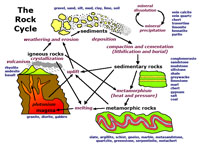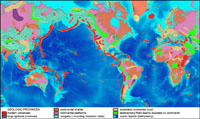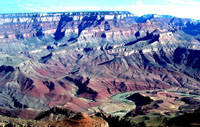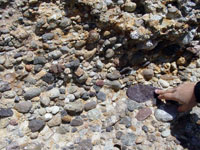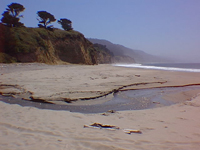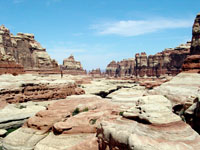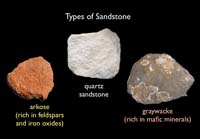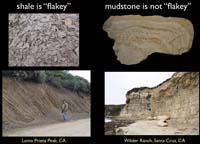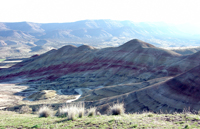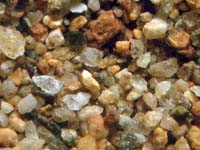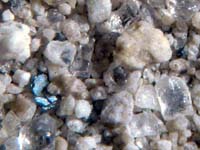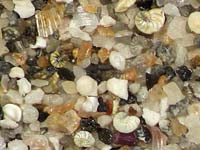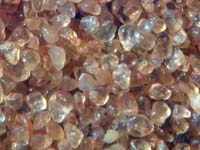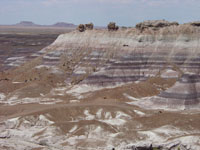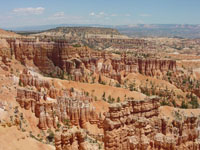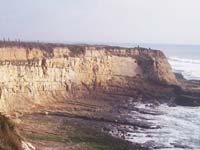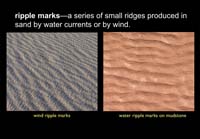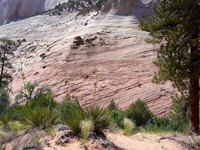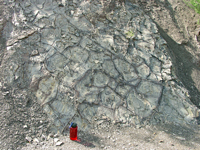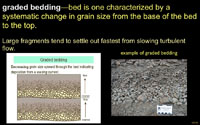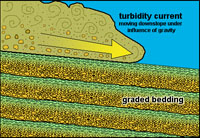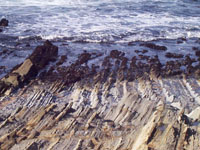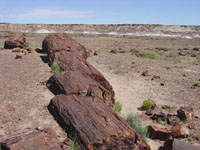
Chapter 10 - Sedimentary Rocks & Processes |
Classification of Sediments and Sedimentary RocksSediments and sedimentary rocks are classified in by origin of source material and by grain size.Classified by origin: There are 4 sources of sediments:a) Lithogenous sediments are sediments derived from terrestrial sources through weathering and erosionb) Biogenous sediments are sediments produced by biological activity c) Hydrogenous sediments are sediments precipitated directly from water d) Cosmogenous sediments are materials that are derived from material entering the atmosphere from outer space. Of the 4 types of sediments, lithogenous and biogenous sediments are the most abundant on Earth today. Hydrogenous sediments are sediments directly precipitated from water. Examples include rocks called evaporites formed by the evaporation of salt bearing water (seawater or briny freshwater). Salt (NaCl) and Gypsum (CaSO4) are Manganese nodules form on the ocean bed (mostly in the deep Pacific) from the slow precipitation of metal oxides in the absence of other kinds of sediments. Cosmogenous sediments originated from outer space. Scientists have used satellites to estimate how much material enters the earth's atmosphere, with current estimates from satellite data suggesting about 100 to 300 tons (mostly cosmic dust) hits earth each day. This is just a tiny fraction of the sediments generated on earth each day. However, early in the history of the Solar System Earth and other planets, moons, comets and asteroids formed from the gravitational accumulation of extraterrestrial material, but by 4.5 million years ago, most of this cosmogenous accumulation had significantly diminished. However, cosmogenous materials including iron-nickel and stony meteorites can be found. Extraterrestrial impacts have changed life on earth repeatedly, including the mass extinction at the end of the Mesozoic Era associated with the extinction of dinosaurs and many other forms of life on land and in the oceans. Tektites are silica glass generated by extraterrestrial impacts. |
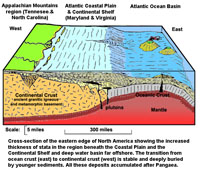 Fig. 10-4. Continental margins are places where large quantities of lithogenous sediments accumulate. In many places around the world the thickness of sediments eroded from continental landmasses and volcanic chains and deposited in the adjacent ocean basin can be many miles thick! |
Fine-Grained Sediments and Sedimentary Rocks (Mudrocks)Mud is a general term lumping together sediments consisting of a mix of clay, silt, and may contain sand. Mud is usually an unsorted mix of fine grain materials. Mud accumulates in quiet water settings separated from where coarser materials have settled out elsewhere (Figure 10-15). Most soil is mud. Mud-rich accumulations are common in river delta regions, swampy coastal regions, tidal flats, and in lake and deep water settings.Mudstone is a fine-grained sedimentary rock formed from the compaction and cementation (lithification) of muddy sediments rich in silt (but may include percentages of fine sand and clay). Shale is a soft, finely stratified sedimentary rock that formed from consolidated mud rich in clay minerals and can be split easily into fragile plates, such as along bedding plains (Figure 10-18). Shale forms from the compaction of sediment dominated by clays. Clays are composed of any microscopic mineral particles. Most dust is clay sized particles. However, there are several types of clay minerals. Clay minerals are any of various hydrated aluminum silicates that have a fine crystalline structure and are components of clay (sediment). Clay minerals form from the weathering of feldspars and other silicate minerals and are the dominant sediment found on Earth. Much of the seafloor world's ocean basins are covered with abyssal clay deposits. Some types of clay minerals can soak up and hold water, and release it when it dries out. These are called expanding clays and are a real problem for home foundations and infrastructure in some parts of the country. When it gets wet it expands. While wet they are slick and have a greasy feel, and sticks to everything. When it dries out, it shrinks and turns hard as rock, and develops a dried, gray popcorn-like texture. Many-a-rancher can tell stories of getting their truck stuck in gumbo as it is often called! |
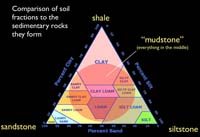 Fig. 10-15. Classification of 'mudrocks' |
Mudrocks are classified similar to soils (discussed in Chapter 9) by the percentage of content of 3 components: sand silt and clay (with the 3 equivalent rocks being sandstone, siltstone, and shale). |
 Fig. 10-16. Certain kinds of Clays are used to make ceramic pottery. Clay is made up of clay minerals. |
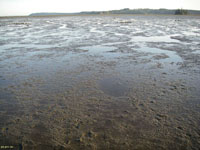 Fig. 10-17. Mud accumulates in quiet-water environments as illustrated with these tidal flats. |
Non-Clastic Sediments and Sedimentary Rocks |
||
| Non-clastic sediments include materials that are not formed by the weathering and erosion of rock, but include sediments formed by precipitation directly from water or formed by accumulation of organic materials. These organic residues form through organic processes (life and death of organisms), particularly microscopic planktonic skeletal material, shells, bone materials, and other organic remains. Bioaccumulation is the buildup of organic remains, such as deposits associated with coral reefs, peat bogs, shell or bone beds, and algae and planktonic ooze. Planktonic ooze is slimy mud sediment on the bottom of an ocean or lakebed formed from the accumulation of skeletal and organic remains of microscopic organisms (Figure 10-22). Calcareous microplankton deposits can become chalk (such as exposed in the White Cliffs of Dove). Siliceous microplankton deposits can become chert (see below). |
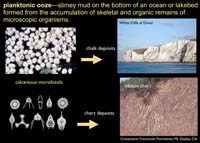 Fig. 10-22. Planktonic ooze forms chalk (calcareous) and chert (siliceous) |
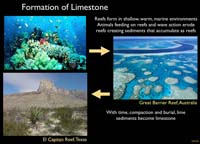 Fig. 10-23. Skeletal remains of calcareous reef organisms erode and accumulate over time and forms limestone |
Limey Sediments and LimestoneLime mud is sediment composed of calcium carbonate (CaCO3) derived from the skeletal remains of shelled organisms, coral, and calcareous algae and plankton. Large amounts of lime mud is created by waves battering reefs and material being chewed up and excreted by reef-living organisms (Figures 10-23 and 10-24). The sediment sediments with compaction and cementation (lithification) become limestone (see below).Limestone is a sedimentary rock consisting predominantly of calcium carbonate (CaCO3) derived from the skeletal remains of marine microorganisms, including shells and coral) and eroded and transported sediments associated with reef environments in shallow, warm tropical marine waters (Figure 10-24). Limestone is commonly used in the manufacture of lime for cement and used as building stone.
|
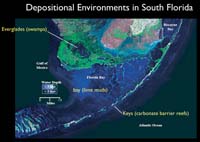 Fig. 10-24. Limey (shallow and warm) depositional environments in South Florida |
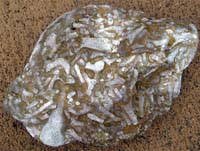 Fig. 10-25. Fossiliferous limestone. This sample from Ohio is loaded with ancient coral like fossil bryozoans. |
|||||||||
 Fig. 10-26. Fossiliferous limestone. This layer from Ohio is a coquina loaded with ancient brachiopod shells. |
 Fig. 10-27. Ooids and oolitic limestone. A variety from Bedford, Indiana was used in the construction of the Empire State Building in NYC. |
||||||||||
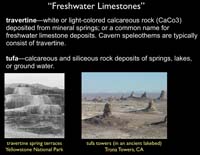 Fig. 10-28. Travertine and Tufa form from spring water releasing and depositing calcium carbonate |
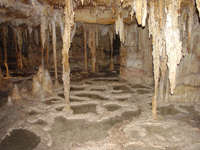 Fig. 10-29. Travertine speleothems (stalactites, stalagmites, and columns); Lehman Cave, Nevada |
||||||||||
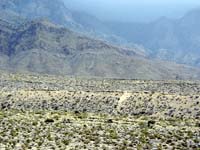 Fig. 10-30. Caliche is a surface soil layer that is tightly cemented by calcium carbonate that commonly forms tough caprock surfaces in desert regions. |
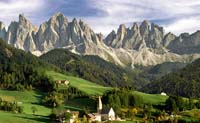 Fig. 10-31. The Dolomites are scenic mountains in northern Italy's Alps and are composed of dolostone. |
Siliceous Non-Clastic Sedimentary SocksChert is a hard, dense sedimentary rock, consisting chiefly of interlocking microscopic crystals of quartz and may contain opal. It has a conchoidal fracture and may occur in a variety of colors. Most chert forms from recrystallization of siliceous microplankton remains (siliceous ooze eventually looses its water content, recrystallizes and turns into chert, Figure 10-32).Flint is a hard (typically gray or brown) rock consisting of nearly pure silica. Flint often occurs as nodules in chalk or limestone. Flint is a variety of chert; both were used by prehistoric peoples around the world to make arrow and spear points (Figure 10-33). |
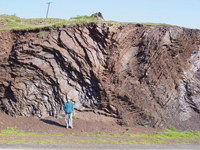 Fig. 10-32. Layers of chert exposed in the Marin Headlands, California |
 Fig. 10-33. Chert and flint arrowheads and spear points from southwestern Ohio. |
Carbonaceous Sediments and Sedimentary RocksOrganic matter is susceptible to breaking down when exposed to oxygen, so organic material (remains of plants and animals) tend not to survive for long when exposed to the air, but the organic residues can survive when buried, and separated from oxygen in air or dissolved in groundwater.Peat is an accumulation of partially decayed vegetation matter that has a brown, soil-like character typically found in of boggy, acid ground or swampy settings. With lithification peat will become coal (Figures 10-34 and 10-35). Organic remains that are rich in fats, oils, and lipids can with exposure to heat over time break down and separate from their source sediments and become deposits of petroleum (oil, natural gas, and tar). The formation of coal, oil, and natural gas are discussed in more detail in Chapter 11). |
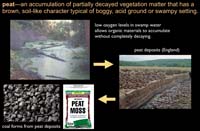 Fig. 10-34. Organic sediments that accumulate in isolated forested swamps (or bogs) can become peat. With time and burial it can become coal |
 Fig. 10-35. Coal seams are ancient forest swamp deposits. These are exposed in Mesa Verde National Park, Colorado |
Evaporites (Salts)An evaporite is a rock composed of salt minerals left behind by the evaporation of salty water.rock salt—a rock dominantly composed of sodium chloride (NaCl - the mineral halite is what rock salt is composed of; Figure 10-36). Rock salt is an evaporite formed in restricted basins with an inflow of seawater located in an arid environmental setting. gypsum—a mineral composed of hydrous calcium sulfate (CaSO4-2H2O); an evaporite mineral used in the manufacture of plaster. Gypsum is deposited by concentrated seawater and by evaporation of freshwater in arid regions. Crystals of gypsum are common in soils in arid regions. If gypsum looses its water content, it is called anhydrite. sylvite—a mineral consisting of potassium chloride (KCl), occurring typically as white, colorless, or pale blue cubic crystals (similar to halite). Sylvite is mined and refined to make potash (potassium-bearing) products including fertilizers, glass, soap, and other commercial and industrial products. It is used as a low-sodium substitute for table salt. Salts are precipitated when sea water (or briny lake water) is concentrated by evaporation. Shorelines along the oceans in hot arid regions of the world are places where salt, gypsum and anhydrite are being deposited today. Examples include around the Persian Gulf and the Great Salt Lake in Utah (Figures 10-38 and 10-39). |
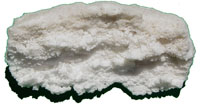 Fig. 10-36. Rock salt (mineral is halite) |
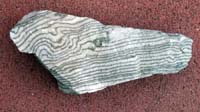 Fig. 10-37. Anhydrite gypsum. |
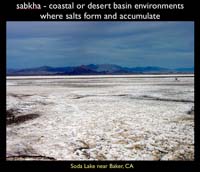 Fig. 10-38. A sabkha is a desert coastal environment is where salts, including halite and gypsum, are commonly deposited. |
 Fig. 10-39. Polygons of salt crystals (halite) being deposited on a salt pan on a dry lake bed in Death Valley National Park, California |
Deposition and Sedimentary Depositional EnvironmentsDeposition is the process of sediments settling and accumulating from a moving fluid (wind, water, or ice). Sediments will erode anywhere where forces associated with currents are strong enough to dislodge and move sediment particles. The "heavier" (both larger and/or denser) the particle, the more energy it take to move. Water is perhaps the primary mover of materials on earth. Wind typical can only move small particles of dust-to-sand-sized particles. Water can move particles of any practically any size if the current is strong enough. Moving glacier ice (though limited to mountainous regions and high latitude regions during Ice Ages) can move materials including house-sized blocks of rock. In general, as a fluid speeds up materials will erode. As the fluid slows down materials will settle out and be deposited. Over time, sediments will accumulate and possibly become buried, becoming permanently deposited until possibly exposed to surface erosion at some later period in geologic time. Places where sediments accumulated are called depositional environments. Depositional environments occur in many different geologic settings on land and under water (examples are illustrated in Figure 10-40).Sedimentary rocks typically preserve numerous clues as to how and where the original sediments were deposited. Over time, regional climates may change, sea level may rise and fall, or tectonic activity, volcanism, or regional erosional patterns may change. As a result, sedimentary rocks exposed in a region may preserve a variety of sedimentary rocks formed in a mix of sedimentary depositional environments during different periods of geologic history. A sedimentary depositional environment includes the combination of physical, chemical and biological processes associated with the deposition of a particular type of sediment. The characteristics of ancient sedimentary depositional environments are often preserved in sedimentary rocks. The term sedimentary facies is used to described the character of a sedimentary rocks expressed by their formation, composition, and fossil content (examples: beach facies, fluvial facies, lacustrine facies). |
 Fig. 10-40. Sedimentary depositional environments occur on land and under water. |
|
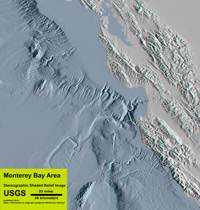 Fig. 10-41. Topography and bathymetry of the Monterey Bay region |
||
Energy in Depositional Environments |
|||
| Sedimentary deposits may preserve aspects of the overall energy conditions of an environmental setting. High energy environments include locations where water is flowing (streams or waves are crashing) but may be locations where coarse sediments (gravel and sand) may selectively settle out, but currents winnow out and remove the finer and lighter materials (silt, clay, organic particles) which will be carried away and deposited in a possibly distant low energy environment. |  Fig. 10-42. Clastic depositional environments in humid regions and marginal marine settings. |
 Fig. 10-43. Depositional environments in arid regions include alluvial fans, dry lake beds, and dunes. |
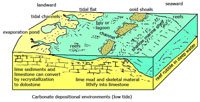 Fig. 10-44. Marine and coastal depositional environments associated with non-clastic sediments and rocks. |
How does kinetic energy in different environmental settings impact how and where sediments accumulate that can become sedimentary rocks?High-Energy and Low-Energy Depositional Environments: Flowing water is the dominant force causing erosion and deposition on Earth (with human mining and construction activity rapidly closing on that claim!). The faster the water moves, the higher the energy in a physical setting. As flowing water increases in speed, the more it may become turbulent, increasing its ability to lift and move particles. Fast moving water can carry materials of different particles ranging from boulders and gravel to finer materials (sand, silt, and clays). Flowing water also sorts sediments by size and density. High-energy environments include river channels, beach and shallow offshore environments (Figures 10-45 to 10-48). Flowing water may let larger materials settle and be deposited while finer materials are carried away and deposited in quieter settings or (low-energy environments) (Figures 10-49 to 10-52).Different sedimentary environments have different energy characteristics that may change from time to time. The forces of energy in a stream will increase as the volume of water increases, such as during flood. For most of a year, a stream will may be a calm environment, that changes during a flood, or during flood season. The same is true of beach and offshore bar environments. As wave energy increases, the greater the amount of energy translates into shoreline erosion and the moving of sediments to quieter and deeper offshore settings. Wave action separates sand from courser and finer fractions, building up or eroding beaches with changing conditions. A beach or offshore region can remain basically calm, relatively low energy for years until a hurricane comes along, and the setting becomes high energy. One big storm event can move more sediments in a few days that might have moved for decades or even centuries. For example, Hurricane Camille did this to the coast of Alabama and Mississippi in 1969. High-energy depositional environments (coarse-grain sediments dominate). Examples include: stream and river channels, beaches, dunes, offshore bars (above wave base)submarine channels and canyons where strong ocean currents persist. Weather (climate) and wave energy are variable factors in high-energy environmental settings. Sediments are constantly being deposited or eroded in these settings. Low-energy depositional environments (fine grained sediments dominate): Examples include: river flood plains, swamps, lakes, lagoons, marshes, and offshore below wave base. Slow-moving currents prevent coarse-grained sediment from migrating into in low-energy depositional environments. Fine materials can be carried long distances before they can settle out in the absence of waves and currents. |
High Energy Depositional Environments | |
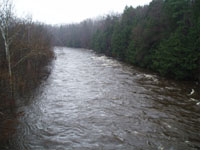 Fig. 10-45. River channels |
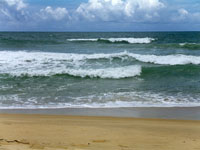 Fig. 10-46. Beaches |
|
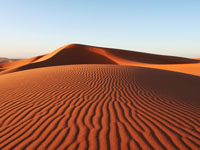 Fig. 10-47. dunes |
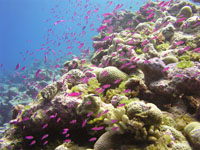 Fig. 10-48. Coral reefs |
|
| Low Energy Depositional Environments | ||
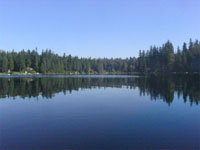 Fig. 10-49. Lake (lacustrine) |
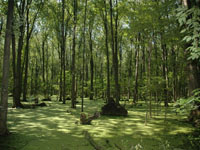 Fig. 10-50. Swamp |
|
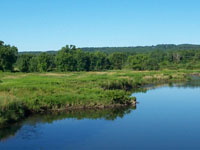 Fig. 10-51. River floodplains |
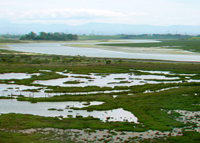 Fig. 10-52. Tidewater marsh |
|
Sedimentary Processes and Sedimentary Structures |
|
Unique characteristics of sedimentary depositsSediments preserve other characteristics that may tell information about the environment where they occur. Sediment particle shapes, degree of sorting, bedding characteristics are typically unique to different geologic settings.Roundness of Sediment GrainsWhen particles are moved by running water they become rounded (roundness is illustrated in Figure 10-61). The corners hit first and are worn down. The sharp edges are also pounded. The particles may become round boulders or pebbles. Bits of sand move with them. As the water slows the largest particles drop out first, making deposits of round boulders and pebbles called conglomerate. The smaller particles are swept away downstream (unless they are trapped between or beneath the large particles). |
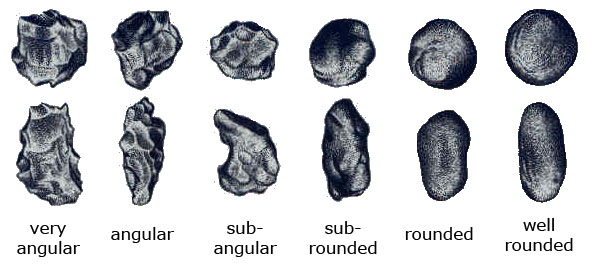 |
| Fig. 10-61. Roundness of sediment grains: The farther a particle is moved, the more rounded and spherical it should become. Angular particles tend to be deposited close to their source, they become more rounded the farther they travel downstream. Grains of beach sand are typically well rounded. Dune sand is typically even more rounded and better sorted (Image from Powers, 1959). | |
SortingThis sediment moving process of running water sorts particles by size and to a lesser degree by shape. This is called sorting (illustrated in Figure 10-62). Sediments exposed to longer transport or exposure to currents and waves tend to be more sorted by shape and size. |
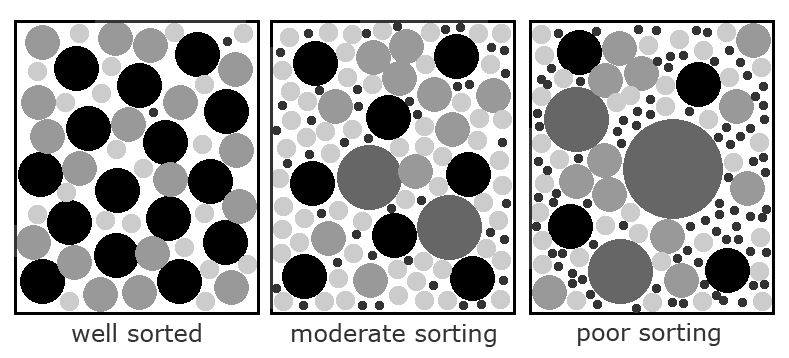 |
| Fig. 10-62. Sorting of sedimentary particles. | |
| The amount of rounding and sorting depends on the environmental energy conditions and
amount of time at which the stream currents or ocean waves works on the particles. Obviously particles of the same
mineral that are more rounded and more sorted have traveled further. The sediments sorting,
roundness, and sphericity could act as a clue to following either modern or ancient alluvial
rocks to their ultimate source. For example, very well sorted and rounded materials may suggest a source
from an older sedimentary rock rather than from freshly exposed igneous rocks. Sand from rivers and stream are very different from sands associated with beach and sand-dune deposits (see Figures 10-63 to 10-67). |
|
Examples Of Different Kinds Of Sand Under Magnification: River, Beach, and Dune Sand |
|||||||||
|
|||||||||
Lamination and BeddingSediments are deposited in layers ranging from paper-thin sheets to massive beds tens to hundreds of feet thick! A laminae (or lamination) is a layer of sediment or sedimentary rock layer only a small fraction of an inch (less than a centimeter) in thickness (see Figure 10-68). Thin lamination is typically associated with fine-grained sediments deposited in quiet or slack-water environments, such as in a lake basin or offshore below the influence of waves and strong currents. Bedding is the smallest division of a sedimentary rock formation or stratigraphic rock series marked by well-defined divisional planes (bedding planes) separating it from layers above and below (see Figure 10-69). A sedimentary rock formation commonly is made up of a series of beds (strata) of similar origin. |
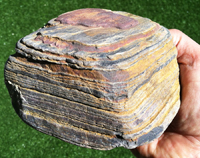 Fig. 10-68. Lamination in shale. Each laminae my be an annual cycle of deposition. |
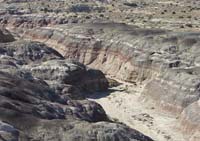 Fig. 10-69. Bedding exposed in a canyon carved in flat-lying sedimentary rocks. |
Sedimentary Rock FormationsThe term rock formation is the primary unit of stratigraphy, consisting of a succession of strata useful for mapping or description. A rock formation typical consists of a unique lithology (rock type) that has a relatively defined geologic age and is considered mappable (meaning that it occurs throughout area or region, both on the surface and in the subsurface). Rock formations can be of igneous, sedimentary, or metamorphic origin. However, Sedimentary rock formations usually consist of beds that preserves information about sedimentary facies they preserve (deposits associated with sedimentary environments, such as shallow marine setting, beaches and nearshore environments, river floodplain deposits, desert dune fields, etc.).Examples of sedimentary rock formations: each of the rock formations illustrated below formed in a corresponding ancient sedimentary depositional environment. |
||||||||
|
Sedimentary Structures Preserved In BeddingSedimentary deposits (including sediments and sedimentary rocks) commonly preserve evidence of how they were deposited. Anyone who has been to the beach or a sand dune area have seen ripple marks created by the movement of sand under the influence of wind or water. Listed below are examples of sedimentary structures preserved in bedding of ancient sedimentary rocks. The processes that created them are the same that are occurring today.Ripple marks—a series of small ridges produced in sand by water currents or by wind (Figure 10-70). Cross bedding—inclined sedimentary structures in a horizontal unit of rock. These tilted structures are deposits from bedforms such as ripples and dunes, and they indicate that the depositional environment contained a flowing fluid (typically, water or wind) (Figure 10-71 and 10-72). Desiccation cracks—mudcracks; an irregular surface fracture pattern formed by shrinkage of clay, silt, or mud under the drying effects of atmospheric conditions at the surface (Figure 10-73). Graded bedding—bed is one characterized by a systematic change in grain or clast size from the base of the bed to the top. Large fragments tend to settle out fastest from a slowing turbulent flow. Turbidity flows—a turbid, dense current of sediments in suspension moving along downslope and along the bottom of a ocean or lake. As turbidity flows slow down, they drop their coarse sediment fractions first, and finer and finer sediments as the currents diminish, resulting in graded bedding. |
||||||||
|
What the significance of fossils in sedimentary rocks?Paleontology is the study of ancient dead things. Paleontologists study fossils and the sediments they were preserved in.A fossil is a remnant or trace of an organism of a some earlier geologic age, such as a skeleton or leaf imprint, embedded and preserved in the earth's crust. Fossilization involves all the processes that turn plant or animal remains to stone. Not all sedimentary rocks preserve fossils. Most animal and plant remains are destroyed by a variety of processes before they can be preserved. However, some "non fossil" evidence is commonly preserved, called "trace fossils." Trace fossils are fossil impressions of footprints, trails, burrows, scratch marks, root traces, or other trace of animals or plants rather than of the organism itself. Trace fossils (also called itchnofossils) are sedimentary structures, like ripple marks and desiccation cracks described above. For example, throughput the western United States, there are many examples of dinosaur trackways. These trace fossils can often provide abundant information about how the ancient creatures interacted with the environment. Bioturbation is the stirring or mixing of sediment or soil by organisms, especially by burrowing, boring, crawling, feeding or other traces left by biological activity. Most sedimentary rocks preserve evidence of bioturbation. As animals dig through the sediments they are typically searching for food or seeking shelter from predators. Over time, burrowing organisms churn up sediments and consume most organic remains in sediment. Paleoecology is the science of studying the relationship of organisms to the sedimentary depositional environments in which their remains have been preserved. Paleoecologists study modern climate settings to compare with the evidence of ancient environments preserved in sedimentary facies. |
||||
|
What is significant about a fossil?The importance of a fossil is to reveal information about:• What was the life habits of the organism—how it lived, what role it had within a community of other organisms, how and why it died. • What was the geologic age and origin of the sedimentary deposits in which it was discovered—what type of environment did the organism the live in? • How was the organism preserved, and why? How did it get to its location, and what happened to it along its journey there? • What geologic events were occurring in the region at the time it was deposited , and what happened over time after the fossil formed. • How does it compare to life habits of similar organisms that exist today? Is it an ancestral form of other known organism? Paleontologists may spend their entire careers collecting and examining fossils in a area or region, comparing fossils in one area with others around the world. The largest employer of paleontologist is the petroleum industry where most work involved studying microfossils (fossil plankton and shell fragments) derived from well cores. Many work for universities and both government and non-governmental organizations studying climate history and climate change, or as curators in museums. There are hundreds of museum collections around the world, supporting the interests of the curious public and preserving precious collections for future generations to study. |
How do fossils form (or better, how do they survive destruction)?1. survive being eaten (at least partially)2. survive transport to a site of preservation 3. survive burial in sediments or volcanic materials 4. survive bioturbation (chewed up by invertebrates) 5. survive bacterial decay and dissolution 6. survive compaction 7. survive chemical changes associated with lithification 8. survive uplift, weathering and erosional exposure 9. discovered and identified (to have educational value) 10. studied, reported, and curated in a museum research collection. Step 10 is extremely important! If you find a fossil you think is important... Tell someone who knows and cares about its possible significance. The best thing to do if it is rare or unusually well preserved is to donate it to a museum. If possible write an article in a published journal about it! Note that many of the most important fossils have been originally found by amateur fossil hunters and collectors. However, it is important to have knowledge about what you are looking for, and to share what you have found! That is the nature of science! |
National Parks Featuring Erosional Landscapes Associated With Sedimentary Rocks |
|
Although many parks are host to sediemtnary rocks, the parks listed here all have have unique erosional features associated with well-exposed sedimentary rock formations. Erosional features include cliff-walled canyons, arches, natural bridges, and pinnacle, mesas, and plateaus. |
 |
| Arches National Park, UT - 1 Badlands National Park, SD - 2 Bighorn Canyon National Recreation Area, MT, WY - 3 Bryce Canyon National Park, UT - 4 Canyonlands National Park, UT - 5 Capitol Reef National Park, UT - 6 Cedar Breaks National Monument, UT - 7 Chaco Culture National Historical Park, NM - 8 Colorado National Monument, CO - 9 Cuyahoga Valley National Park, OH - 10 Glen Canyon National Recreation Area, AZ - 11 Grand Canyon National Park, AZ - 12 Mesa Verde National Park, CO - 13 Natural Bridges National Monument, UT - 14 Rainbow Bridge National Monument, UT - 15 Red River Gorge Geologic Area, KY - 16 Scotts Bluff National Monument, NB - 17 Theodore Roosevelt National Park, ND - 18 Zion National Park, UT - 19 |
|
| Chapter 10 Quiz Questions |
| https://gotbooks.miracosta.edu/earth_science/chapter10.html | 6/4/2018 |
